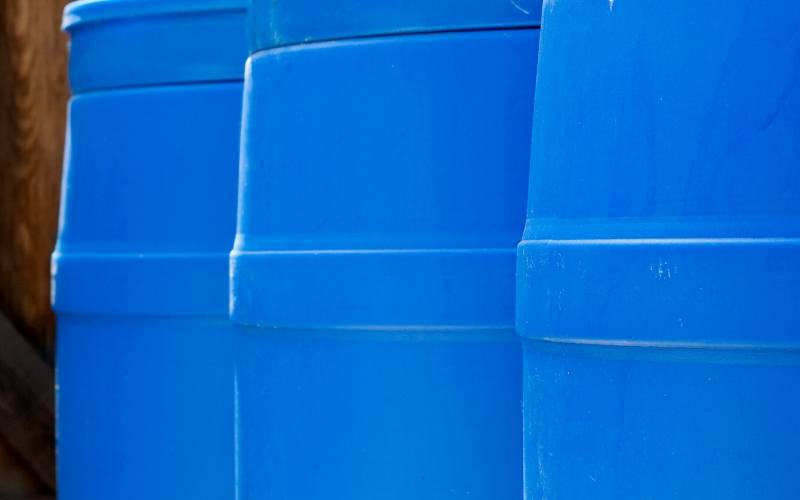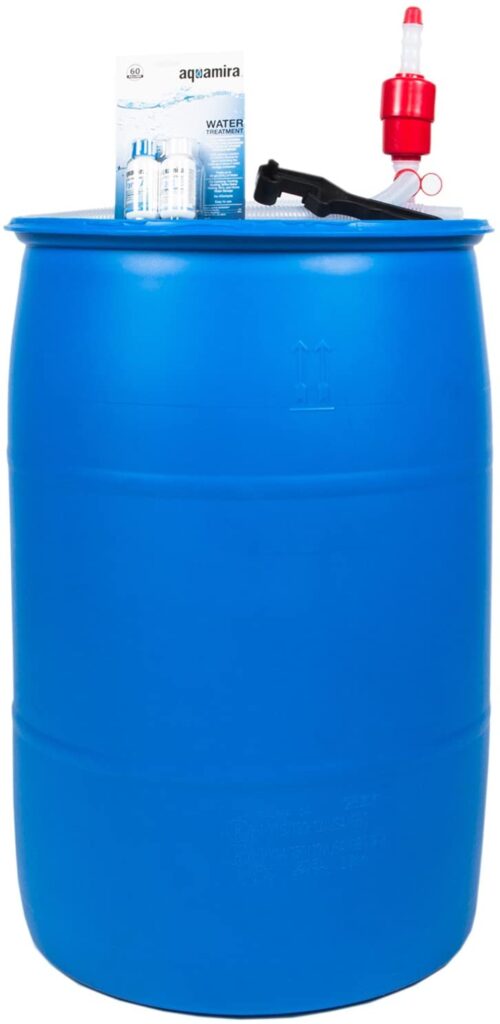Considering the various types of disasters and catastrophes that many people face in different places in the world it is important to consider how you can plan to provide the very basic human needs, including food and water, for your family and yourself. According to Healthline.com “You won’t live long without consuming a healthy amount of water. It’s only possible to survive without water for a matter of days. You may be susceptible to the effects of dehydration even sooner, depending on certain factors.” Clearly, it is important that we learn how to purify and store large amounts of water. So how do you store large amounts of water?
How to store large amounts of water in a food-grade barrel or Drum:
- Determine how much water you need
- Select a high-quality, large food-grade barrel
- Thoroughly clean and disinfect the barrel
- Add potable drinking water
- Disinfectant large amounts of water if needed
- Store large water barrels in a clean and appropriate location
Also, it is critical that you know how to safely and easily purify water at home in case your stored water or other water sources become contaminated. And for those who have colder seasons like use see how to keep water storage from freezing outside.
Determine how much water you need to store

In order to decide really how much water you should store for yourself and each of your family members, you may want to consider a few different factors, such as; age, health, physical condition, physical activity, diet, and climate. To get a general idea of the minimum amount of water you should store check out our Water Storage Calculator.
The CDC suggests that you store 1 gallon of water per person per day for drinking and sanitization. This might be more than enough water for a toddler to survive while at the same time it isn’t enough water for adults to take a comfortable bath. The idea is that 1 gallon per person will sustain life. However, highly active people that live in hot climates may want to increase the amount of water that they store for daily use.
Take the following into account:
- Children, nursing mothers, and sick people may need more water.
- A medical emergency might require additional water.
- If you live in a warm-weather climate more water may be necessary. In very hot temperatures, water needs can double.
How much water to store Chart
| Water storage by Uses | 1 Month of Water for 1 Person | Two Weeks of Water for 1 Person | 3 Days of Water for 1 Person |
|---|---|---|---|
| Drinking-Water | 16 gallons 60 Liters | 7 – 8 gallons 26 – 30 Liters | 2 – 3 gallons 7.5 – 11 Liters |
| Cooking (food preparation) Water | 8 gallons 30 Liters | 4 gallons 15 Liters | 1 – 1.5 gallons 4 – 6 Liters |
| Washing (Sanitizing) Water | 8 gallons 30 Liters | 4 gallons 15 Liters | 1 – 1.5 gallons 4 – 6 Liters |
“Store at least one gallon of water per person for drinking and sanitation. A normally active person needs about three quarters of a gallon of fluid daily, from water and other beverages. However, individual needs vary depending on age, health, physical condition, activity, diet and climate.”
Department of Homeland Security
Select a high-quality, large food-grade water barrel
Many types of containers are available for water storage. Containers should be “food grade,” meaning they were meant to hold food or water. The most commonly used containers are glass, plastic, and metal. The best containers have secure lids and a spout or spigot that allows for dispensing water with minimal or no contamination.
See a complete guide of ideas for the best water storage containers.
Plastic (food-grade barrel, drum, or containers)
Plastic bottles or jugs previously used for beverages make excellent containers. They are lightweight and fairly sturdy. However, in order to store large amounts of water, we suggest getting a large water storage barrel such as a 55-gallon (208 Liters).
What to look for in a large water storage barrel or drum
- Make sure it is food-grade plastic that is BPA-Free
- Has a top that can be closed tightly
- Is made of durable, unbreakable plastic
- 55-gallon water storage barrels are great for storing large amounts of water
- Comes with a pump and hose
- Getting a hand siphon pump, and a hose is important to avoid contaminating your water supply when accessing your water storage.
- Lid opener (sometimes referred to as a bung wrench or drum bung wrench)
So what is the best large 55-gallon water storage barrel/drum?
Augason Farms Water Filtration and Storage Kit 55 Gallon Water Drum
55-gallons | BPA Free
Includes:
- two fittings,
- easy-to-use hand siphon pump,
- 6-foot siphon hose,
- lid opener
- Aquamira Water Treatment pack (treats up to 60 gallons of water)
If you have space and you’re looking to have at least one month of water storage on hand, you can’t go wrong with 55-gallon water barrels. They’re made from sturdy food-grade plastic and have bungs at the top that can be sealed super tight in order to protect your water from contamination. The plastic is also BPA-free and UV-resistant. Two of these drums can give a small family up to a couple of weeks of water. This is what I have right now for my water storage solution.
Glass Water Containers
Glass provides a fairly effective container for storage and is non-permeable to vapors and gases. Glass should not be the sole means of water storage since it is easily broken and may be damaged during an emergency.
Glass is impractical to use for water storage of large amounts of water.
Metal Water Containers
Stainless steel can successfully be used for water storage. Other metals are not optimal containers unless they are coated and made specifically to hold food or water. Pewter or lead-soldered metals should be avoided.
Stainless steel can be used to store large amounts of water but can be challenging in several ways so we prefer to store large amounts of water in food-grade plastic barrels and containers.
Thoroughly clean and disinfect the barrel
Water containers should be cleaned with warm, soapy water and rinsed. Special attention should be given to containers that previously contained food or beverages.
- Fill the container with potable tap water
- Add 1 tablespoon bleach for each 1 gallon of water
- Shake well, turning the bottle upside down a time or two to sanitize the cap
- Let stand for 1 minute, and then pour out the bleach water
- Let the container air dry.
Add potable water
Once the barrel is thoroughly cleaned and located in its permanent home, fill it with the cleanest water available.
We use a clean RV drinking water hose (Check the price on Amazon) when filling a water barrel to ensure that the water is not contaminated while you are filling it. Garden hoses that have been sitting outside in the yard can collect contaminates. We store our hose with the ends screwed together to prevent contamination. However, a garden hose will get the job done if that is all that you have.
Disinfectant large amounts of water if needed
Tap water or well water is not sterile. The few microorganisms present can multiply during storage and have the potential to cause illness. Water that is to be stored for long periods of time should be treated to control microbial growth. Be sure to use the best quality water possible for storage.
Boiling Method
Boiling is a good way to purify water. Bring the water to a rolling boil for 1 to 3 minutes. After the water has cooled, fill your clean water storage barrel or drum.
- Boiled water will taste better if you put oxygen back in it before drinking. To restore the oxygen, pour the water back and forth between two clean containers several times.
Chlorine Treatment
Liquid chlorine bleach (unscented) can be used to disinfect water for long-term storage. Use fresh chlorine bleach since it can lose up to half its strength after 6 months. One gallon of water can be treated by the addition of 1/8 teaspoon of liquid chlorine bleach containing 4 to 6 percent sodium hypochlorite. (Most bleach contains 5.25 percent.) This is equivalent to 8 drops of liquid chlorine bleach. During storage, the bleach will break down into oxygen and table salt.
How much bleach do you add to stored water? long term water storage bleach ratio
| Water Amount | 1,000 Gallons | 300 Gallons | 275 Gallons | 55 Gallons | 1 Gallon |
|---|---|---|---|---|---|
| Bleach to Clear Water | 2 & 1/2 cups | 3/4 cup | 2/3 cup | 2 Tablespoons & 1 teaspoon | 8 Drops |
| Bleach to Cloudy Water | 5 cups | 1 & 1/2 cups | 1 & 1/3 cups | 5 Tablespoons | 16 Drops |
Water Purification Tablets
Different types of tablets are available for water purification purposes. Be sure to follow the manufacturer’s directions for treatment and allow sufficient time for the chemical to work before using the water. Check the label for the expiration date since the tablets can become ineffective with time. Most tablets have a storage life of 2 to 5 years unopened.
Here is a great option for water purification tablets (100 pack) on Amazon!
Water Filtration Units
You can filter water if you have a commercial or backpack filter that filters to 1 micron. Storing a large amount of water might be impractical for you depending on your situation so having a good water filter that you can fit in a bag or 72-hour kit could be life-saving.
For more information about water filters and how to know exactly which one is right for you see our article Selecting the Best Emergency Water Filters: Buyers Guide.
The Survivor Filter PRO (See on Amazon) is one that I use camping and have on hand for emergencies. It is great because it filters to 0.01 Microns to remove viruses, bacteria, parasites, and reduces most heavy metals, taste, and chemicals.
Our favorite personal filtration straw is the Sawyer Mini Filtration System (See on Amazon). The best part about this Sawyer Mini filter is that it filters up to 100,000 gallons (400,000 liters) of water whereas the LifeStraw only filters up to 1,000 gallons (4,000 liters) of water.
Bottled Water
Bottled water can be a quick and convenient way to store water. It is convenient to have quick bottled water on hand for drinking water. Standards for public water supplies are set by the Environmental Protection Agency and those for bottled water are set by the U.S. Food and Drug Administration (FDA). Additionally, the International Bottled Water Association (IBWA) works with the industry to assure that FDA regulations are followed, assuring a safe, high-quality product.
We suggest having some packages of bottled water on hand in addition to your large water storage containers.
Store large water barrels in a clean and appropriate location
Storage conditions should include:
- clean
- dry place
- off the ground
- away from sunlight
Since plastic is permeable to certain vapors, water stored in plastic should not be near gasoline, kerosene, pesticides, or similar substances.
If you have freezer space, store water in the freezer. It not only acts as water storage but if the electricity goes out, it will help keep foods frozen. Leave 2 to 3 inches of headspace in the container to allow for expansion as the water freezes.
When potable (drinkable) water is properly disinfected and stored, it should have an indefinite shelf life. To maintain optimum quality, water should be checked every 6 to 12 months. Check for secure lids, broken or cracked containers, and for cloudiness. Replace the water and treat it as before.


